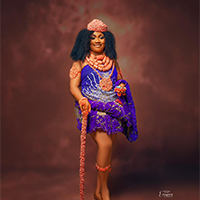Kalabari traditional weddings in Nigeria involve various rituals, including “buying the mouth” (Bibife), and the groom is required to provide a list of items to the bride’s family.
Three types of marriage exist: Iya (highest and most expensive), Igwa, and Waribiobesime. Divorce is not permitted in Iya marriages.
Key aspects of Kalabari traditional weddings:
Bibife (Buying the Mouth):
This ceremony signifies that the bride cannot eat in her husband’s house until her “mouth” is purchased, and her family can eat in the house.
Groom’s Responsibility: The groom is expected to provide a list of items or monetary gifts to the bride’s family before the wedding.
Types of Marriages:
- Iya: The most lawful and expensive form of marriage, with no divorce allowed.
- Igwa: A form of marriage.
- Waribiobesime: A form of marriage.
Betrothal Gift: Betrothal gifts are an indicator of social relationship between families, not legal consequences
Ari Ibara Emi: The cheapest form of marriage recognized in Kalabari, where the bride is considered “with me” and her parents should not seek her elsewhere.
The Traditional wedding attire
This includes a Mgbeete, which is a collection of various wrappers tied around the waist, often paired with a blouse, corals, and a cap. The attire signifies the bride’s traditional identity and the rich cultural heritage of the Kalabari people.
Mgbeete: The Mgbeete is the main traditional attire for an Onne-Eleme maiden, representing a collection of wrappers tied around the waist.
Blouse: The Mgbeete is often paired with a blouse, a common practice in Nigerian traditional attire.
Corals: Coral beads are a significant part of Kalabari ceremonial attire, symbolizing wealth and nobility.
Cap: A cap, often worn with the Mgbeete, adds to the overall traditional look.
Ekpé Mgbeete: The Ekpé Mgbeete, worn on the legs, is another element of the traditional Kalabari attire.
Significance: The Kalabari cultural attire is more than just clothing; it’s a symbol of the Kalabari people’s identity, heritage, and culture.
Cultural Preservation: The attire is a way for the Kalabari people to connect with their roots and preserve their culture for future generations.

